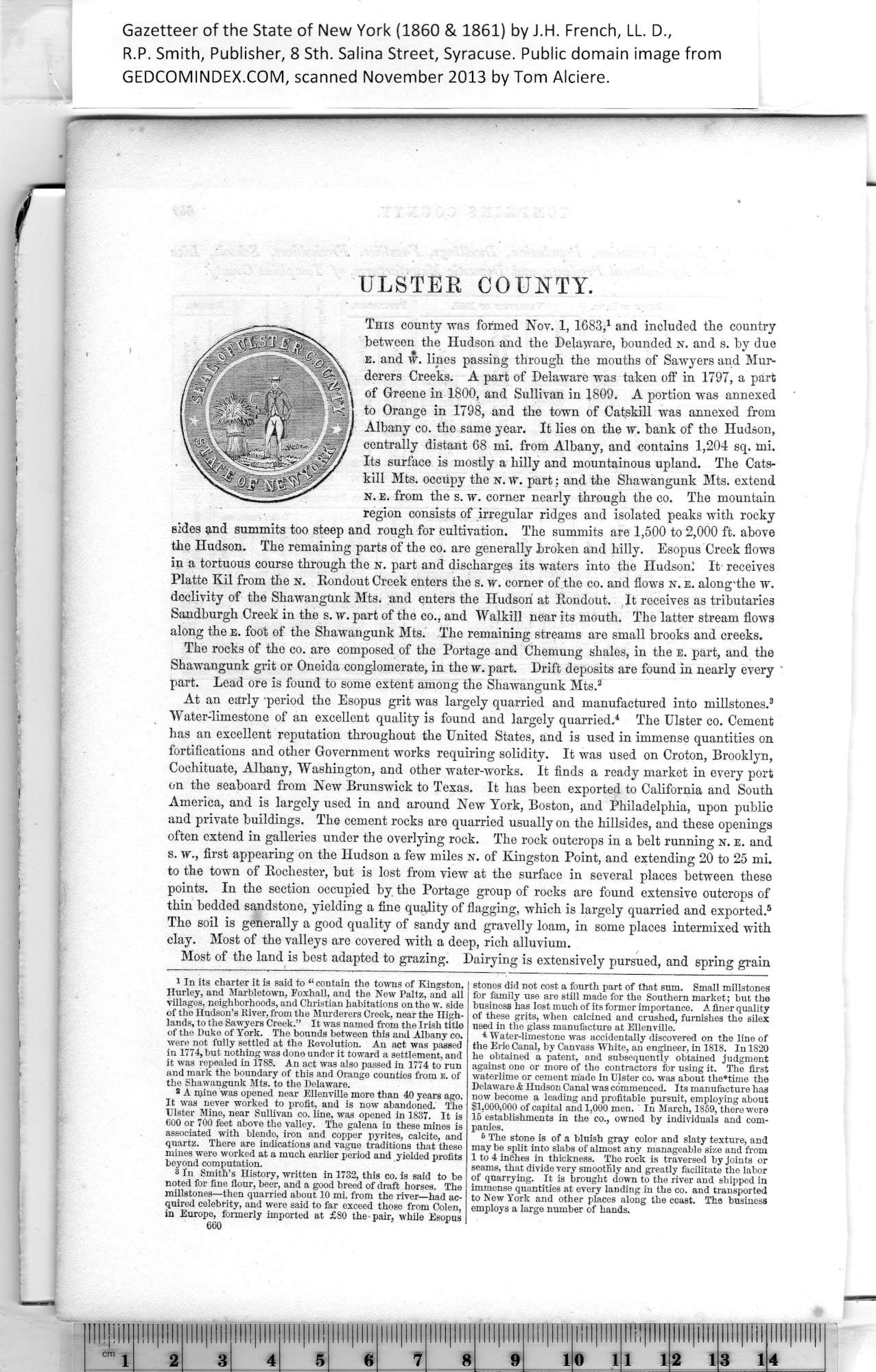|
ULSTER COUNTY.
This county was formed Not. 1, 1683,1 and included the country
between the Hudson and the Delaware, bounded n. and s. by due
E. and w. lines passing through the mouths of Sawyers and Mur¬
derers Creeks. A part of Delaware was taken off in 1797, a part
of Greene in 1800, and Sullivan in 1809. A portion was annexed
to Orange in 1798, and the town of Catskiil was annexed from
Albany co. the same year. It lies on the w. bank of the Hudson,
centrally distant 68 mi. from Albany, and contains 1,204 sq. mi.
Its surface is mostly a hilly and mountainous upland. The Cats-
kill Mts. occupy the n. w. part; and the Shawangunk Mts. extend
N. e. from the s. w. corner nearly through the co. The mountain
region consists of irregular ridges and isolated peaks with rocky
sides and summits too steep and rough for cultivation. The summits are 1,500 to 2,000 ft. above
the Hudson. The remaining parts of the co. are generally broken and hilly. Esopus Creek flows
in a tortuous course through the n. part and discharges its waters into the Hudson: It receives
Platte Kil from the n. Kondout Creek enters the s. w. corner of the co. and flows n. e. along'the w.
declivity of the Shawangunk Mts. and enters the Hudson at Eondout. It receives as tributaries
Sandburgh Creek in the s. w. part of the co., and Walkill near its mouth. The latter stream flows
along the e. foot of the Shawangunk Mts. The remaining streams are small brooks and creeks.
The rocks of the co. are composed of the Portage and Chemung shales, in the e. part, and the
Shawangunk grit or Oneida conglomerate, in the w. part. Drift deposits are found in nearly every
part. Lead ore is found to some extent among the Shawangunk Mts.2
At an early period the Esopus grit was largely quarried and manufactured into millstones.2
Water-limestone of an excellent quality is found and largely quarried.4 The Ulster co. Cement
has an excellent reputation throughout the United States, and is used in immense quantities on
fortifications and other Government works requiring solidity. It was used on Croton, Brooklyn,
Cochituate, Albany, Washington, and other water-works. It finds a ready market in every port
on the seaboard from New Brunswick to Texas. It has been exported to California and South
America, and is largely used in and around New York, Boston, and Philadelphia, upon public
and private buildings. The cement rocks are quarried usually on the hillsides, and these openings
often extend in galleries under the overlying rock. The rock outcrops in a belt running sr. e. and
s. w., first appearing on the Hudson a few miles sr. of Kingston Point, and extending 20 to 25 mi.
to the town of Kochester, but is lost from view at the surface in several places between these
points. In the section occupied by the Portage group of rocks are found extensive outcrops of
thin bedded sandstone, yielding a fine quality of flagging, which is largely quarried and exported.3
The soil is generally a good quality of sandy and gravelly loam, in some places intermixed with
clay. Most of the valleys are covered with a deep, rich alluvium.
Most of the land is best adapted to grazing. Dairying is extensively pursued, and spring grain
|
stones did not cost a fourth part of that sum. Small millstones
for family use are still made for the Southern market; but the
business has lost much of its former importance. A finer quality
of these grits, when calcined and crushed, furnishes the silex
used in the glass manufacture at Ellenville.
4 Water-limestone was accidentally discovered on the line of
the Erie Canal, by Canvass White, an engineer, in 1818. In 1820
he obtained a patent, and subsequently obtained judgment
against one or more of the contractors for using it. The first
waterlime or cement made in Ulster co. was about the’time the
Delaware & Hudson Canal was commenced. Its manufacture has
now become a leading and profitable pursuit, employing about
$1,000,000 of capital and 1,000 men. In March, 1859, there were
15 establishments in the CO., owned by individuals and com-
6 The stone is of a bluish gray color and slaty texture, and
may be split into slabs of almost any manageable size and from
1 to 4 inches in thickness. The rock is traversed by joints or
seams, that divide very smoothly and greatly facilitate the labor
of quarrying. It is brought down to the river and shipped in
immense quantities at every landing in the co. and transported
to New York and other places along the coast. The business
employs a large number of hands. |
1
In its charter it is said to “ contain the towns of Kingston,
Hurley, and Marbletown, Foxhall, and the New Paltz, and all
villages, neighborhoods, and Christian habitations on the w. side
of the Hudson’s River, from the Murderers Creek, near the High¬
lands, to the Sawyers Creek.” It was named from the Irish title
2
were not fully settled at the Revolution. An act was passed
in 1774, but nothing was done under it toward a settlement, and
it was repealed in 1788. An act was also passed in 1774 to run
and mark the boundary of this and Orange counties from E. of
the Shawangunk Mts. to the Delaware.
3
s In Smith’s History, written in 1732, this co. is said to be
noted for fine flour, beer, and a good breed of draft horses. The
millstones—then quarried about 10 mi. from the river—had ac¬
quired celebrity, and were said to far exceed those from Colen,
in Europe, formerly imported at £80 the pair, while Esopus
|
